Scottish National Investment Bank consultation: analysis of responses
Analysis of responses to Scottish National Investment Bank consultation which ran from 5 September to 31 October 2018.
5. Analysis of questions
This section contains an in-depth analysis of the views and opinions shared during the consultation process. The themes and views identified have been presented within the same format as the consultation paper. It should be noted that there are instances where a single response has been stated. In such cases, the response was judged to be pertinent to the question, and often provided an alternative view.
5.1. The opportunity and the Bank’s objectives and purpose (Questions 1 and 2)
This section discusses the views and opinions of respondents in assessing the proposed objectives and purposes for the Bank; and also to gain insight into respondents’ views on the Bank’s Vision. Respondents were asked to consider two questions:
- Question 1: Are the proposed objectives and purposes for the Bank the most appropriate to deliver the Implementation Plan’s recommendations, and to fulfil the Bank’s potential contribution to increasing sustainable economic growth?
- Question 2: Do you have views on the statement of the Vision which has been set for the Bank, in paragraph 3.2?
Question 1 was made up of two parts, firstly it allowed respondents to give a pre-defined response with the options of “Yes”, “No” and “Don’t Know”; and then gave the respondents the opportunity to provide further explanation for their answer. It should be noted that not all respondents who answered from the predefined list gave a further explanation and vice-versa. Question 2 was open-ended and allowed respondents to provide comments and views on the question.
Each question has been considered individually in the following sections.
Question 1
For the first part of Question 1 there were 37 valid responses, 44% of all respondents. Overall, respondents were in favour of the Bank’s proposed objectives and purposes as illustrated in Figure 1.
Figure 1: Question 1 Responses – Are the proposed objectives and purposes for the Bank the most appropriate to deliver the Implementation Plan’s recommendations, and to fulfil the Bank’s potential contribution to increasing sustainable economic growth?
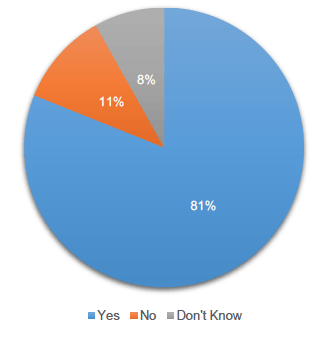
Source: Consultation Hub
81% of respondents supported the view that the Bank’s proposed objectives and purposes are most appropriate to deliver the Implementation Plan’s recommendations, and to fulfil the Bank’s potential contribution to increasing sustainable economic growth.
For the second part of Question 1, respondents were asked to provide further explanation on whether “the proposed objectives and purposes for the Bank were the most appropriate to deliver the Implementation Plan’s recommendations”. There were 46 valid responses recorded, 55% of all respondents. Within these responses, 9 free-form responses are included as they covered matters relevant to the question.
Responses generally fell within broad themes, responses which did not address a common theme were captured under “Other”. Each of these are explored in further detail, the main themes identified were:
- Carbon Reduction
- SME Growth
- Innovation
- Ethical Investment
- Sustainable Economic Growth
The responses for each key theme are profiled in Figure 2; it should be noted that some responses covered more than one theme.
Figure 2: Question 1 Themes
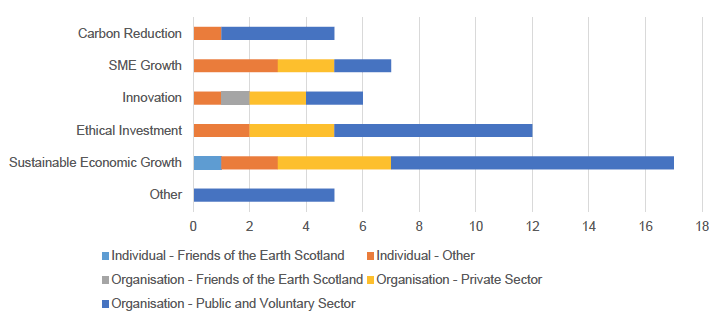
Source: Consultation Hub
Carbon Reduction
It was generally supported that investment should be targeted towards a low carbon, sustainable future; and that the Bank should help fund renewable energy initiatives, such as wind, solar and wave power. A small number of respondents commented that clarity is needed to understand how environmental sustainability will feature in the Bank’s investment activities. It should be noted that the Cabinet has agreed transferring to a low carbon economy as a possible early mission for the Bank.
One respondent expressed the view that the Bank’s low carbon objective should be aligned to environmental sustainability strategies, such as the Scottish Energy Strategy or Energy Efficient Scotland programme.
SME Growth
Responses were generally supportive of the Bank’s objective to serve SMEs who wish to grow their businesses. Some respondents commented that the Bank presents an opportunity to support SMEs through patient capital investment who may otherwise struggle to get financing through traditional means. There were, however, a small number of respondents who expressed the view that the Bank should not be an easy way for SMEs to gain cheaper financial products than are already available to them, and should be for those who truly struggle to get financing.
Innovation
Respondents were supportive of the Bank’s objective to support innovation, with Friends of the Earth Scotland commenting that it was critical that the Bank supports emerging technology. Some respondents expressed the view that the Bank should help fund new innovation, such as biotechnology and the creative industries sector.
A small number of respondents commented that the provision of patient capital will be vital to support innovation in Scotland.
Ethical Investment
Several respondents supported the Bank’s approach to investing ethically. Some respondents commented that it is important for the Bank to have a structure which allows it to invest ethically in areas such as social infrastructure, affordable housing, community investment; and investment which would not otherwise be attractive to private investors, but which would improve quality of life, public health and the natural environment in Scotland.
It was agreed by some respondents that the Bank should not have a retail arm given the competition which already exists in this market, and should focus on investment which is not currently provided in the commercial market.
Sustainable Economic Growth
Responses were generally supportive of the Bank’s objective to increase sustainable economic growth, with several respondents explicitly supporting the Scottish Government’s priority to increase sustainable economic growth. A small number of respondents agreed that a long-term view on growth was essential and this could be achieved through the provision of patient capital and a mission-led focus.
One respondent commented that achieving regional economic growth is a critical component of a strategic approach to creating and sustaining balanced and inclusive growth in Scotland. Another respondent commented that effective measurement of the Bank’s impact on the economy over a longer time period will be important in determining the Bank’s success and value for money.
One opposing response expressed the view that the aims of the Bank should not include sustainable economic growth but should instead focus on alignment with climate change strategies. Another view was that the consultation paper lacked rigorous analysis of the gaps in the investment market.
Other
A number of other themes were identified that did not fall under any of the broad themes already identified. One respondent identified the need for the Bank to carry out risk assessments to consider environmental risk as part of any investment. A small number of respondents expressed the view that the specific needs and opportunities of women should be considered within the Bank’s objectives, and that there should be a specific focus on businesses owned or led by women.
One respondent commented that the Bank’s objectives should include a focused investment on housing development and growth in small scale house builders in more rural areas.
Question 2
Respondents were asked to provide “views on the statement of the Vision which has been set for the Bank”. There were 62 valid responses recorded, 74% of all respondents. Within these responses, 7 free-form responses are included as they covered matters relevant to the question.
Responses generally fell within broad themes, responses which did not address a common theme were captured under “Other”. Each of these are explored in further detail, the main themes identified were:
- Carbon Reduction
- SME Growth
- Innovation
- Ethical Investment
- Sustainable Economic Growth
The responses per grouping are profiled in Figure 3; it should be noted that some responses covered more than one theme.
Figure 3: Question 2 Themes
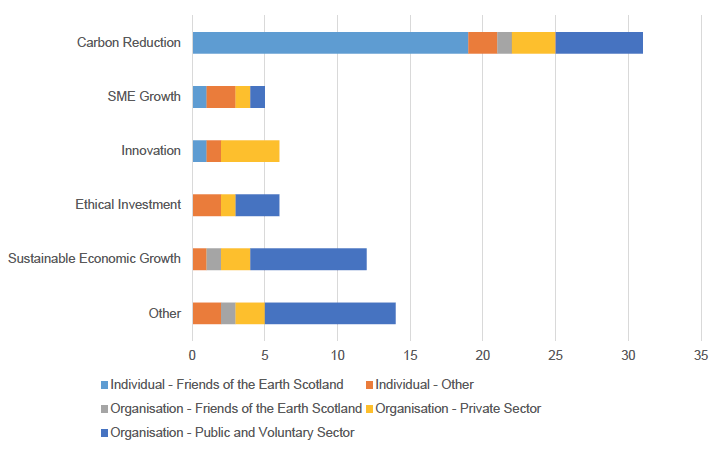
Source: Consultation Hub
Carbon Reduction
It was generally supported that the Vision should include the move towards a low carbon economy. Many respondents, including Friends of the Earth Scotland, expressed the opinion that the Bank’s Vision should be to provide finance and act to catalyse investment for the move to a low carbon economy. A small number of respondents also commented that the Vision should also include explicit reference to the circular economy with the aim of reducing consumption of raw materials.
A small number of respondents suggested that focus should not solely be on low carbon as there is already a significant number of lenders willing to provide financing in this sector, and other types of businesses are important in the wider economy.
One respondent also expressed the view that clarity was needed around how the Bank plans to make the transition to green energy.
SME Growth
Responses were supportive of the Bank’s focus to support SMEs. Some respondents expressed the view that SME growth should be a focus of the Bank’s Vision and that support of SMEs is essential to achieve growth for the Scottish economy. Additionally, one respondent also welcomed the Bank’s Vision, and in particular its aim of increasing the quantity and quality of business investment in the Scottish economy and supporting growing businesses.
One respondent commented that the provision of patient capital could protect ambitious SMEs from potential future recessions.
Innovation
Respondents generally supported the Bank’s Vision to support and accelerate innovation, with a small number of respondents commenting that the Bank should focus on investment in advanced technological developments that will shape the future of Scotland and allow it to compete globally.
One respondent expressed the view that the Bank must truly support innovation, and not simply be a way to allow companies to access cheap financing for doing what they are doing now.
Ethical Investment
Some respondents expressed the view that the Bank delivers a focus on financial support for specific societal challenges such as social infrastructure, social enterprise, inequality and other appropriate social-capital activities.
One respondent recommended that the Bank considers a broader remit for the types of commercial activities that it intends to provide financial assistance to. The respondent commented that the Bank should be enabling, promoting or sustaining economic development at a local and community level.
Sustainable Economic Growth
There were differing views around the Bank’s Vision to achieve growth for the Scottish economy. A small number of respondents expressed the view that the Bank will play an important role in increasing Scotland’s level of economic growth through crowding-in investment, providing patient capital and through driving economic activity that is inclusive and environmentally sound. One respondent also commented that the Bank should adopt a Vision and missions that ensures that all investments contribute towards National Outcomes, act as a catalyst for private investment towards the Sustainable Development Goals, and support a sustainable and inclusive economy that is globally engaged.
An alternative view was expressed by some respondents; one respondent commented that there are industries in Scotland which could benefit from better access to finance but which do not fall within the categories indicated by the statement of Vision. In addition, a small number of respondents questioned whether there is sufficient focus on inclusive economic growth in the Vision and commented that the Bank needs to ensure that growth is spread across Scotland and across all ages and genders. Finally, one respondent stated concern that the Vision focuses too heavily on economic growth and too little on securing social and environmental benefits.
Other
A number of other themes were identified that did not fall under any of the broad themes already identified. A small number of respondents commented that further clarification is needed as to how the Vision will apply to certain sectors such as the creative industries sector and public sector. One respondent also commented that “inclusive growth” needs to be defined to ensure gender inequality is addressed in practice.
Some respondents expressed the importance of the Vision being protected in such a way as to be resistant to attempts to alter its initial purposes, and to ensure that it cannot be changed to align with any future political changes.
5.2. The focus for investment activities (Questions 3 to 7)
This section discusses the views and opinions of respondents around the Bank’s proposed investment activities. This includes the Bank’s mission-based approach, relationship and structures, approach to investment and the Bank’s ethical commitment. Respondents were asked to consider five questions:
- Question 3: Do you agree that the overall direction for the Bank should be set by Ministers through a Strategic Framework, including the setting of missions and performance objectives and a target rate of financial return?
- Question 4: Do you have any views and suggestions on the example of missions, outlined in paragraph 4.7 and what are these?
- Question 5: Do you agree that the Bank should identify and implement an Investment Strategy, which is along the lines suggested?
- Question 6: Are there any arrangements or requirements not already considered that would inform the Equalities Impact Assessment and strengthen and enhance the Bank’s ethical approach to investment, and what are these?
- Question 7: Do you agree with the principles approach that is proposed for the Bank, including publication of an Ethics Statement by the Board?
Questions 3, 5 and 7 were made up of two parts, firstly it allowed respondents to give a pre-defined response with the options of “Yes”, “No” and “Don’t Know” and then gave the opportunity to provide further explanation for their answer. It should be noted that not all respondents who answered from the pre-defined list gave a further explanation and vice-versa. Questions 4 and 6 were open-ended and allowed respondents to provide comments and views on the question.
Each question has been considered individually in the following sections.
Question 3
For the first part of Question 3 there were 36 valid responses, 43% of all respondents. Overall, respondents were in favour that the overall direction for the Bank should be set by Ministers through a Strategic Framework.
Figure 4: Question 3 Responses Do you agree that the overall direction for the Bank should be set by Ministers through a Strategic Framework, including the setting of missions and performance objectives and a target rate of financial return?
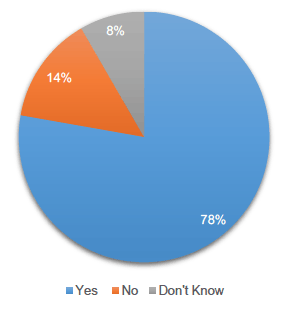
Source: Consultation Hub
For the second part of Question 3, respondents were asked to provide further explanation on whether “the overall direction for the Bank should be set by Ministers through a Strategic Framework”. There were 39 valid responses recorded, 46% of all respondents. Within these responses, 3 free-form responses are included as they covered matters relevant to the question.
Responses generally fell within broad themes, responses which did not address a common theme were captured under “Other”. Each of these are explored in further detail, the main themes identified were:
- Ministerial Direction
- Stakeholder Views
- Independence of the Bank
- Financial Return Targets
The responses per grouping are profiled in Figure 5, it should be noted that some responses covered more than one theme.
Figure 5: Question 3 Themes
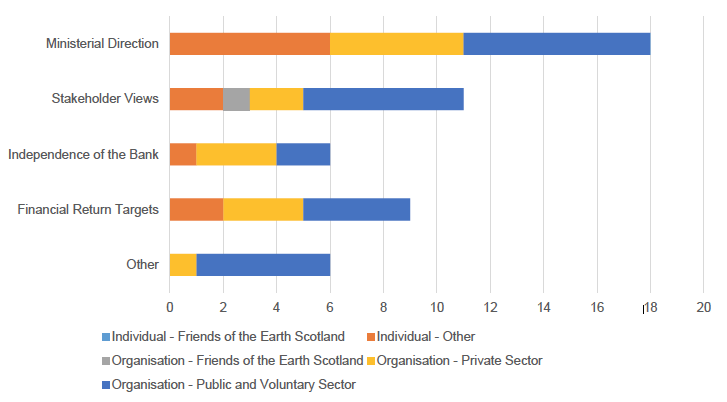
Source: Consultation Hub
Ministerial Direction
Whilst many respondents supported the view that the Strategic Framework for the Bank should be set by Ministers, there were a small number of differing opinions and other concerns raised. Many respondents agreed that setting out a Strategic Framework should be the responsibility of Ministers; and that it is important to establish a proper, transparent and robust Strategic Framework. Some respondents, however, expressed the view that after Ministers have set the Strategic Framework preventions should be put in place to avoid the Bank becoming a political instrument.
A small number of respondents also expressed the view that if the Bank is to have a long-term investment approach, it should consider how to balance this with potential shorter-term political interests and ensure consistency in the Bank’s activities is achieved regardless of future changes in Government.
Stakeholder Views
Some respondents expressed the view that the Strategic Framework for the Bank should be prepared in consultation with wider key stakeholders. Generally, respondents commented that Ministers need to have access to external input to inform the decisions made, and a number of suggestions were made.
One respondent suggested a tripartite stakeholder model where those with financial, public good and economic development interests are represented. A small number of respondents also suggested that the Bank should consult with leadership from the public sector (specifically local government). Additionally, one respondent suggested the Bank’s staff should be engaged in setting the Strategic Framework.
A small number of respondents also expressed the view that the Advisory Group should be involved in setting the Strategic Framework as a provider of industry and market-based expertise. It was also suggested that the Advisory Group will be more effective if it is given statutory status as a mechanism to balance any potential politicisation of the Bank.
Friends of the Earth Scotland commented that the Strategic Framework should embed the Bank being wholly mission-led and public-purpose driven in all it does.
Independence of the Bank
Respondents generally agreed that the Bank should be operationally independent from Government and should have a high degree of operational freedom in terms of delivering against the Strategic Framework. One respondent commented that targets should be set and the Bank should be allowed to operate freely to achieve these targets. Another respondent remarked that the Bank’s autonomy, and its relationship with the Scottish Government and its other agencies, should be agreed and respected by all parties and clearly established by the Strategic Framework.
A small number of respondents expressed the view that operations of the Bank should not be influenced politically to avoid the purpose and objectives significantly changing.
Financial Return Targets
A small number of respondents expressed the view that the Board should be responsible for setting a target rate of return, and a small number of respondents also commented that this should be done in conjunction with key stakeholders such as the Advisory Group and then approved by Ministers.
A small number of respondents also remarked that financial return targets should not harm the Bank’s social objectives and Ministers should not lose sight of the social impact the Bank aims to create. Another respondent commented that financial returns for the Bank have the potential to be impacted negatively by mission-based investment strategies and the Bank's performance indicators in this area should be set to make allowance for this.
Finally, one respondent suggested that KPIs should also include the Bank’s broader social and economic remit alongside financial return targets.
Other
A number of other themes were identified that did not fall under any of the broad themes already identified. A small number of respondents commented that further clarification needs to be provided in terms of the Bank’s mission-based approach and further detail provided on how the Bank will promote inclusive growth and the circular economy.
One respondent commented that a process of periodic review would be beneficial to understand the overall economic benefit which is achieved by the Bank. Finally, one respondent commented that when setting the missions of the Bank there should be lending criteria to promote equality through making it a lending requirement for potential beneficiaries to adopt policies and practices conducive to women’s equality.
Question 4
Respondents were asked to provide “views and suggestions on the example of missions”. There were 58 valid responses recorded, 69% of all respondents. Within these responses, 7 free-form responses are included as they covered matters relevant to the question.
Responses generally fell within broad themes, responses which did not address a common theme were captured under “Other”. Each of these are explored in further detail, the main themes identified were:
- Carbon Reduction
- Ageing Population
- Innovation
- Ethical Investment
The responses per grouping are profiled in Figure 6, it should be noted that some responses covered more than one theme.
Figure 6: Question 4 Themes
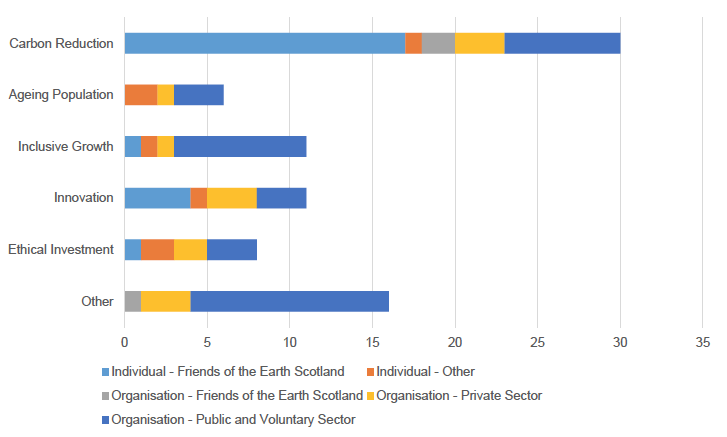
Source: Consultation Hub
Carbon Reduction
A significant number of respondents indicated that carbon reduction should be a key mission for the Bank. From the examples of missions provided it is clear that there is a view that the Bank should invest in projects which demonstrate significant cuts in carbon emissions, such as offshore wind, public transport, solar, offshore wave, renewable heating and cooling. One respondent also suggested providing finance for retrofitting of old houses, eco-homes, green energy and social enterprises.
A small number of respondents also suggested that the Bank’s missions should include the circular economy with focus on productive use of recycling and wastes and the bio-economy.
One alternative view was that the Bank would struggle to compete with financial institutions who invest in green energy and renewables as this industry is already adequately covered by existing types of investment.
Ageing Population
A small number of respondents welcomed the Bank’s mission to respond to an ageing population and one respondent identified it as the most important mission. There were, however, a small number of respondents who commented that clarity is needed around how the Bank will do this.
One respondent suggested it would be beneficial to have an understanding of what exactly is meant by responding to an ageing population and what areas the Bank will seek to invest as certain activities (nursing homes) are already covered by existing types of investment.
Inclusive Growth
Several respondents supported the Bank’s aim to promote inclusive growth and commented that the focus on inclusive growth will require the Bank to be open to the provision of innovative financing and patient capital in order to drive inclusive growth. It was the view of one respondent that this will in turn allow the economy to grow and create employment and provide a rate of return to the Bank.
A small number of respondents expressed the view that gender equality must drive the missions and the Bank’s lending criteria should focus on women from all backgrounds in order to promote women-owned businesses.
One respondent commented that further clarification on place-making and regeneration is needed as the definition of this is not clear from the Consultation.
Innovation
A number of varying suggestions were provided concerning innovation. A small number of respondents shared the view that a mission that might be considered is to capitalise on the science and technology work in Scotland's universities to improve access to education worldwide and using new technology to deliver this to a global audience.
A further view which was shared between some respondents is to position Scotland as a leader in innovation by investing in the financial technology sector, provide financing for precision medicine and investment in digital economy such as automation, robotics, artificial intelligence, big data, nanotechnology, biotechnology and investment in a new data infrastructure.
A small number of respondents also expressed the view that the Bank should focus on ecologically oriented activities such as investing in new farming techniques, green farming techniques and animal welfare.
Ethical Investment
Ethical investment is supported by many respondents. A small number of respondents commented that it is important for the Bank to have a strict ethical lending criteria and support should be provided to businesses whose aim is to improve the environment and the health and wellbeing of the people living in Scotland.
Another suggestion from a small number of respondents was for the Bank to consider missions around protecting fair work and tackling social issues such as fuel poverty.
Other
A number of other themes were identified that did not fall under any of the broad themes already identified. A small number of respondents commented that the Bank should engage with smaller organisations and local government when identifying missions.
A small number of respondents also suggested that the Bank should support community land and asset development to help deliver the key infrastructure and community facilities that are required to support housing developments.
Some respondents also commented that the missions need to be further clarified and refined.
Question 5
For the first part of Question 5 there were 35 valid responses, 42% of all respondents. Overall, respondents were in favour of the Bank identifying and implementing an Investment Strategy.
Figure 7: Question 5 Responses Do you agree that the Bank should identify and implement an Investment Strategy, which is along the lines suggested?
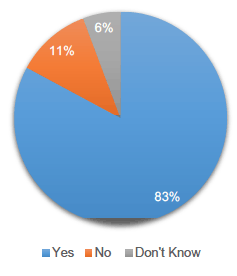
Source: Consultation Hub
For the second part of Question 5, respondents were asked to provide further explanation on whether “the Bank should identify and implement an Investment Strategy”. There were 47 valid responses recorded, 56% of all respondents. Within these responses, 3 free-form responses are included as they covered matters relevant to the question.
Six recurring themes were identified in the responses to Question 5. Various responses which did not address a common theme were captured under “Other”. Themes identified:
- Scottish Investment
- Carbon Reduction
- SME Growth
- Innovation
- Ethical Investment
- Inclusive Growth
The responses per grouping are profiled in Figure 8, it should be noted that some responses covered more than one theme.
Figure 8: Question 5 Themes
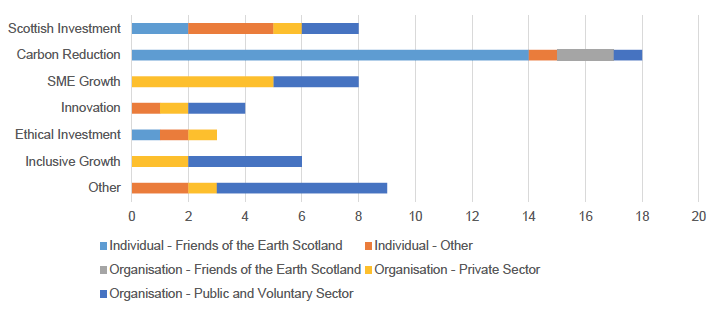
Source: Consultation Hub
Scottish Investment
Some respondents agreed that investments should be made to either Scottish companies, companies with a substantial presence in Scotland or where a positive economic impact will be made in Scotland. Specifically, one respondent also included a focus on sustainability as a priority. One respondent mentioned that financing should allow growth across the entire spectrum of Scottish businesses, while another mentioned the financing should connect the Scottish economy to the global economy, and promote global investment within Scotland.
One respondent suggested the Bank should focus on public sector infrastructure and public housing to gain a stable portfolio. One respondent stated the need for support in rural development, the financing of co-ops and public interest companies. Finally, one respondent stated the financing should tackle inequality by aligning with the Community Empowerment Act and Child Poverty Act.
Carbon Reduction
Many respondents, including the Friends of the Earth individuals and campaign responses called for the Bank’s activities to align with plans for delivering the Scottish Climate Change Act’s targets, and should explicitly rule out lending to fossil fuel projects. Specifically, one respondent added that any investment towards the arms trade should be ruled out, while another added that fossil fuel projects should only be considered if carbon capture and storage are included.
The remaining responses regarding carbon reduction were all against high-carbon projects, with one respondent suggesting the investment strategy should consider a wide range of zero-carbon investment.
SME Growth
Some respondents supported the view that the Bank should focus on financing SME start up and growth. A small number stated the financing should target those businesses who find it challenging to secure commercial financing currently, while a small number mentioned specifically SMEs within the property and construction sectors as those who could benefit from the financing. Additionally, some respondents explicitly praised the commitment to patient capital.
One respondent stated that the view within the financial community is that there is a lack of demand from SMEs for growth financing, which is the reason for the absence of substantial investment. The respondent warned that SMEs may be wary of accessing finance and are not fully aware as to what financing is currently available.
Innovation
A small number of responses stated that the Bank’s products should cater to the technology sector, and encourage the creation and shaping of new markets. One respondent explicitly stated that this would mean further tailoring of products beyond debt and equity.
One respondent suggested financing should focus on investments relating to innovation, and skills training.
Ethical Investment
One respondent specified that ethical investment should be a core and vital prerequisite to financing. Additionally, one respondent called for investments that have the potential to deepen inequality, or to reinforce commercial interests to be explicitly ruled out.
Inclusive Growth
A small number of respondents emphasised the importance of the Bank including mechanisms which allow and encourage inclusive economic growth. Specifically, one respondent requested the proposed strategy further identify how the Bank can further women’s equality in the context of gender inclusive growth. One respondent suggested a focus on businesses owned or driven by women could be adopted as part of the economic objectives of the Bank.
With regard to business, one respondent suggested the Bank should target struggling businesses, and help to provide capital, while another stressed the importance of all areas of the economy benefiting from the Bank. Finally, one respondent added that there should be a commitment to the Bank delivering projects which benefit communities.
Other
A small number of respondents were unclear on how the Bank’s risk appetite will differ from traditional banks, requesting any risk appetite proposed should be scrutinised by Ministers.
One respondent raised concern that the missions and risk strategy could restrict the Bank from operating effectively. Additionally, one respondent suggested that social impact should be a key consideration for the investment strategy.
Question 6
Respondents were asked to provide views on whether “there were any arrangements or requirements not already considered that would inform the Equalities Impact Assessment and strengthen and enhance the Bank’s ethical approach to investment”. There were 38 valid responses recorded, 45% of all respondents. Within these responses, 5 free-form responses are included as they covered matters relevant to the question. Three recurring themes were identified in the responses to Question 6. Various responses which did not address a common theme were captured under “Other”. Themes identified:
- Ethical Investment
- SME Growth
- Openness and Transparency
The responses per grouping are profiled in Figure 9, it should be noted that some responses covered more than one theme.
Figure 9: Question 6 Themes
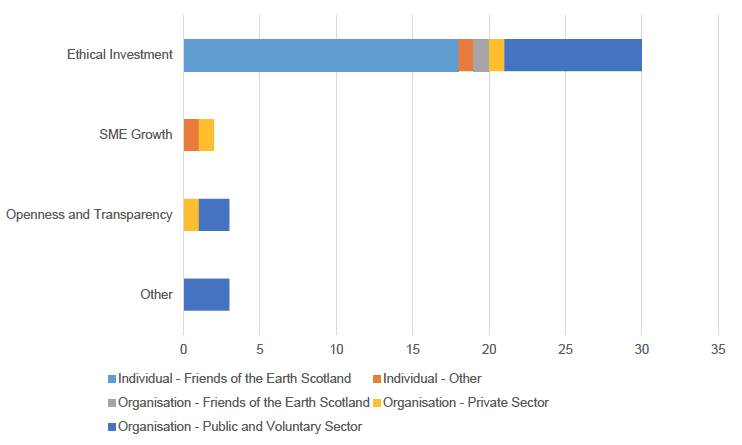
Source: Consultation Hub
Ethical Investment
Many respondents, including the Friends of the Earth responses, suggested the Bank’s ethical lending criteria must rule out investing in projects causing pollution. One respondent suggested that financing should be ruled out for businesses where employers do not tackle existing inequality, while another stated businesses should be made to show how their projects will benefit the community, wages and workers as opposed to only shareholders. Additionally, one respondent stated ethical investment should also consider the impact to the global supply chain.
A small number of respondents specifically called for ruling out investment in projects that harm health and communities, such as tobacco and gambling, as well as unethical sectors such as the arms trade.
One respondent raised concern with unintentionally locking out certain businesses in need of financing, and recommended ethical arrangements should be developed with businesses to avoid this.
One respondent suggested that investment should be spread across all sectors, as opposed to just the private sector, and focus on financial inclusion and social enterprise. Additionally, it was mentioned that there should be consideration of the social impact of projects and their contribution to the wellbeing economy.
A small number of respondents stated that the Bank should encourage and aid the participation of women and marginalised groups. One respondent requested the Bank’s finance portfolio of projects and companies reflect Scotland’s diversity. One respondent suggested the Bank should evaluate the percentage of financing towards businesses owned or operated by women and ethnic minorities and ensure the make-up of the Bank’s Board addresses gender balance and representation of ethnic minorities.
Finally, one respondent requested further clarity on what the Bank considers ethical, and who is responsible for determining this.
SME Growth
One respondent suggested the Bank should ensure businesses maintain control when offering equity financing. Another respondent warned against burdening SMEs with reporting obligations around its performance against its equality and ethical investment targets.
Openness and Transparency
A small number of responses were supportive of the arrangements and requirements considered so far, with one respondent stressing that Bank officials must adhere to a code of conduct that supports the Ethics Statement.
One respondent was concerned that the Equality Impact Assessment was uncompleted at the time of the consultation, and questioned the possible efficacy of the assessment when completed so late in the policy development.
Other
One respondent suggested the development of a property portfolio, focusing on projects such as social housing, should be included within the Bank’s ethical approach. One response stated the Bank should aid a reduction in poverty by aligning aims with the Sustainable Growth Commission’s recommendations.
Question 7
For the first part of Question 7, there were 39 valid responses recorded, 46% of all respondents. Overall, respondents agreed with the principles approach that is proposed for the Bank.
Figure 10: Question 7 Responses Do you agree with the principles approach that is proposed for the Bank, including publication of an Ethics Statement by the Board?
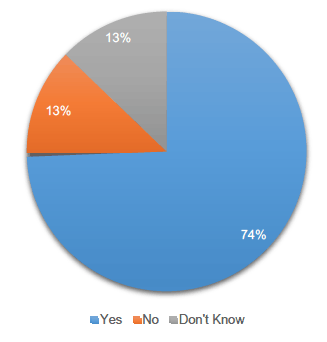
Source: Consultation Hub
For the second part of Question 7, there were 28 valid responses recorded, 33% of all respondents. Within these responses, 3 free-form responses are included as they covered matters relevant to the question. Two recurring themes were identified in the responses to Question 7. Various responses which did not address a common theme were captured under “Other”. Themes identified:
- Ethical Investment
- Openness and Transparency
The responses per grouping are profiled in Figure 11, it should be noted that some responses covered more than one theme.
Figure 11: Question 7 Themes
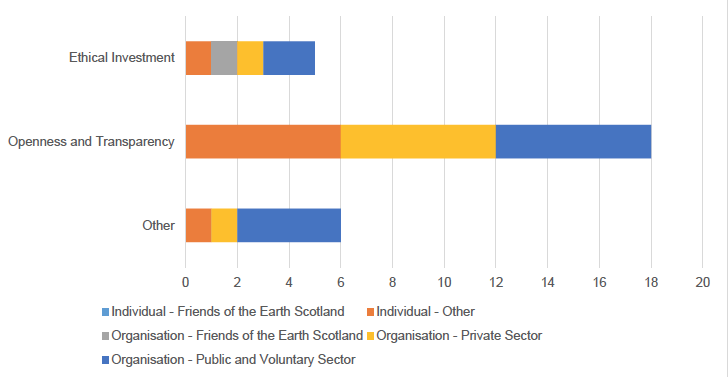
Source: Consultation Hub
Ethical Investment
Friends of the Earth propose setting a minimum standards assessment to adhere to basic environmental, human rights and financial transparency standards. A small number of respondents also supported the establishment of a formal ethical investment approach. One respondent stated all investments that cause damage to society or the environment should be ruled out, while another respondent suggested the principle of One Planet Prosperity should be adhered to.
Finally, one respondent stated that investment should be tied to the quality of employment on offer, fair work principles, and the procurement of materials and services from local suppliers.
Openness and Transparency
All respondents were supportive of the Bank being as open and transparent as possible. A small number of respondents stated that transparency is key to rebuild the trust that has been eroded between the public, government and banks. A small number of respondents stated the Bank should be able to display how its investment activities promote inclusive growth, and can be viewed as ethical.
A small number of respondents suggested that the ethical professionalism shown by the Bank could allow it to become a leader in ethical standards for banks, and encourage key partners to adopt similar ethical policies.
One respondent suggested that transparency is included as a principle of the Bank’s investment strategy. Another respondent acknowledged that the consideration of ethics is constantly evolving, and the approach to reviewing and renewing the Ethics Statement should reflect this.
One respondent reiterated the concern that ethical requirements should be in place to inform the development of the Bank. Conversely, one respondent suggested the ethics statement should not be established up front, rather informed by the initial activities of the Bank. Finally, one respondent requested clarity in how sustainability, socio-economic disadvantage and community benefit could feature within the Ethics Statement.
Other
One respondent requested further clarification on how the public can have further and ongoing input into the development of the Bank.
One respondent requested that consideration be given to the principles of the Fair Work Framework. A small number of respondents asked for more detail on how the Ethics Statement might be developed and enforced. Specifically, one respondent stated that additional to the ethical principles, an Environmental and Social Risk Management System should be required to enforce them. The respondent also called for the Bank to follow the principles set out in the Collevecchio Declaration.
5.3. Operating model, classification and capitalisation (Questions 8 to 10)
This section discusses the views and opinions of the respondents in assessing the proposed operating model, classification and capitalisation of the Bank. Respondents were asked to consider three questions:
- Question 8: Is there a better option than the Public Limited Company model, and if so what is it and why?
- Question 9: Do you have views at this stage on the proposals for capitalisation of the Bank?
- Question 10: Do you have views on how the governance and classification of the Bank should evolve over time, and if so, what measures and protections should be included now to guide and inform a future change in governance and classification of the Bank?
All three questions were open-ended and allowed respondents to provide comments on the question.
Each question has been considered individually in the following sections.
Question 8
Respondents were asked to provide views on “is there a better option than the Public Limited Company model”. There were 20 valid responses recorded, 24% of all respondents. Within these responses, 2 free-form responses are included as they covered matters relevant to the question. One recurring theme was identified within the responses to Question 8. Various responses which did not address a common theme were captured under “Other”. Theme Identified:
- Company Model
The responses per grouping are profiled in Figure 12, it should be noted that some responses covered more than one theme.
Figure 12: Question 8 Themes
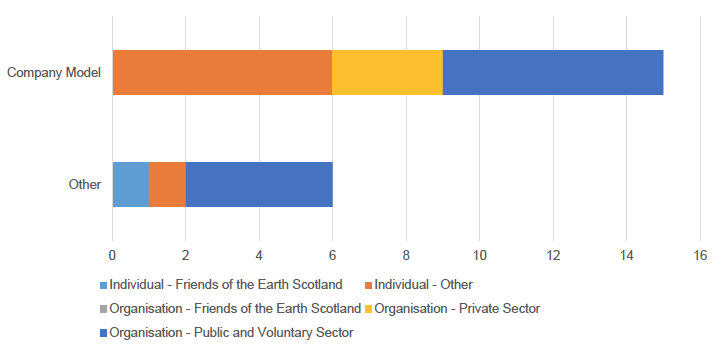
Source: Consultation Hub
Company Model
Some responses that addressed the company model, supported the public limited company model suggested. However, a small number of respondents, including one who supported the PLC model, raised concern over shareholders seeking to prioritise maximising profits and the negative impact this might have on the Bank’s missions. One respondent was unclear on the value of making the Bank public, when there is no immediate need for finance to be raised to capitalise the Bank.
A small number of respondents expressed support for a cooperative or stakeholder model for the Bank. Additionally, one respondent supported the company limited by guarantee model. Finally, one respondent highlighted that the model chosen should be one that fits within and supports the wellbeing economy.
Other
A small number of respondents stated the importance of the Bank’s accounts and activities being subject to public audit, requiring the annual report and accounts to be sent to the Auditor General for Scotland. A small number of respondents raised the concern of privatisation, or in one case the eventual closure, of the Bank. These respondents felt the Bank should remain within the public domain. One respondent desired further clarity towards any dividend payment structure, and one other was unclear on how the Government will raise funds for the Bank.
Question 9
Respondents were asked to provide views on “the proposals for capitalisation of the Bank”. There were 29 valid responses recorded, 33% of all respondents. Within these responses, 2 free-form responses are included as they covered matters relevant to the question. Two recurring themes were identified in the responses to Question 9. Various responses which did not address a common theme were captured under “Other”. Themes identified:
- Finance
- Governance
The responses per grouping are profiled in Figure 13, it should be noted that some responses covered more than one theme.
Figure 13: Question 9 Themes
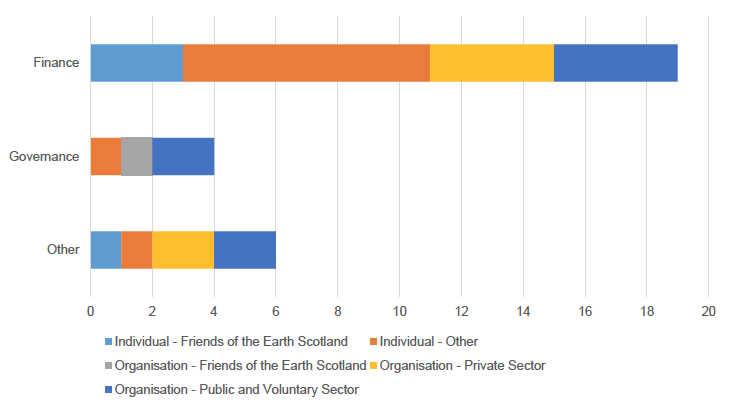
Source: Consultation Hub
Finance
Some respondents felt that the proposed capitalisation level was insufficient to make an impact in the market. Both the initial £490 million capitalisation, and the long term £2 billion capitalisation were seen as inadequate to deliver the transformative impact desired. Of these respondents, all broadly agreed with the method of capitalisation, with a small number explicitly stating their support. One respondent expressed the view that successfully addressing the gaps in the market with the level of capital proposed was the challenge.
Several alternative capitalisation methods were also suggested. One respondent advocated the issue of bonds by the Bank, while a small number suggested both public and private investment should be utilised. With regards to the latter, a small number of respondents supported the idea of the public being able to invest in the Bank, stating the opportunity to invest ethically, locally and long term was both attractive and not currently available.
A small number of respondents questioned whether the expected returns were too optimistic. These respondents stated the Bank should expect that not all investments will make a return, and that patience was necessary, along with effective deployment, to take advantage of the limited capitalisation available.
One respondent raised concern over the stability of financing long term, stating that any amount of capitalisation promised should be protected against shifts within the political landscape. Additionally, one respondent recommended that the full capitalisation amount of £2 billion should be brought forward and made available by 2020.
One respondent stated that any major investment should only be agreed after necessary due diligence was carried out, while one respondent was unclear on how the capitalisation would be raised within the public sector.
Governance
One respondent suggested the Bank should come under the remit of the Scottish Government at all times, and be administered by the Scottish Government.
Friends of the Earth Scotland individuals and campaign responses stated the Bank should be capitalised by public and private investment, enabling local authorities, pension funds and other public bodies to invest in the Bank.
One respondent supported a Limited by Guarantee model, as it would allow public sector organisations to invest capital as and when it is required.
Other
One respondent suggested that the people of Scotland should be given the opportunity to become shareholders in the Bank. Another suggested tax breaks could be offered to organisations who invested in the Bank. To ensure the Bank is solvent and financially successful one respondent suggested the Bank’s loan portfolio be mixed, with low to medium risk investments.
Several concerns were also raised within the responses. One respondent was concerned by the Bank’s apparent lack of a resilience plan to counteract economic turbulence. Another questioned whether the Bank would be able to afford the flexibility offered by private financial lenders, as classification to the public sector could present limitations.
Finally, one respondent stressed the importance of transparency, to ensure public money is being used in the public interest.
Question 10
Respondents were asked to provide views on “how the governance and classification of the Bank should evolve over time”. There were 23 valid responses recorded, 27% of all respondents. Within these responses, 5 free-form responses are included as they covered matters relevant to the question. Two recurring themes were identified in the responses to Question 10:
- Stakeholder Engagement
- Governance
The responses per grouping are profiled in Figure 14, it should be noted that some responses covered more than one theme.
Figure 14: Question 10 Themes

Source: Consultation Hub
Stakeholder Engagement
All the responses broadly recognised the importance of stakeholder engagement. A small number of respondents stated support for representation from a wide range of stakeholders, including the banking, public, private, and third sector.
One respondent commented on the importance of the Advisory Group and Stakeholder Working Group being given genuine powers to help ensure the Bank remains focused on the missions.
One respondent stated this opportunity should be used to review the governance of public bodies, agencies and institutions by the Scottish Government.
Governance
It was generally agreed that the ownership of the Bank should be operated and kept within the public domain, and was suggested by one respondent that this provision should be within the Bill and the Bank’s Articles of Association. Friends of the Earth Scotland explicitly stated their support for the public sector classification of the Bank. One respondent added that the Bank should, at the same time, be protected against political manipulation by the Government.
Some respondents mentioned the importance of the Bank maintaining and adhering to its ethical ethos, and avoiding political interference and influence. One respondent suggested that governance should be aligned with the Strategic Framework, Investment Strategy and Ethics Statement, to ensure this.
A small number of respondents expressed a desire for the Bank’s governance to be more democratic, and inclusive than has been suggested currently. A small number of respondents stated a desire for the Bank to obtain a full banking licence.
There were differing views on the future financing of the Bank, with one respondent arguing the Bank should not become a self-financing body, and another arguing the converse.
One respondent suggested governance should move away from Ministerial control to allow the Bank to develop successfully. One respondent recommended further clarity on the accountability and methods of addressing conflicts of interest between obligations towards the Bank and responsibilities to Parliament.
5.4. Governance Arrangements (Questions 11 to 13)
This section discusses the views and opinions of the respondents in assessing the proposed governance arrangement of the Bank. Respondents were asked to consider three questions:
- Question 11: Do you agree with the proposed approach to the Bank’s governance and Board arrangements which will inform the Bill, the Articles of Association and a Strategic Framework document?
- Question 12: Do you have any comments on the need for the Bank to have Delegated Powers, in order to achieve the aim of it being operational and administratively independent?
- Question 13: Do you have views on whether and how an Advisory Group could provide advice to Ministers on issues relating to the Bank?
Question 11 was made up of two parts, firstly it allowed respondents to give a pre-defined response with the options of “Yes”, “No” and “Don’t Know” and then gave the opportunity to provide further explanation for their answer. It should be noted that not all respondents who answered from the pre-defined list gave a further explanation and vice-versa. Question 12 and 13 were open-ended and allowed respondents to provide comments on the question.
Each question has been considered individually in the following sections.
Question 11
For the first part of Question 11, there were 33 valid responses recorded, 39% of all respondents. Overall, respondents agreed with the proposed approach to the Bank’s governance and Board arrangements.
Figure 15: Question 11 Responses Do you agree with the proposed approach to the Bank’s governance and Board arrangements which will inform the Bill, the Articles of Association and a Strategic Framework document?
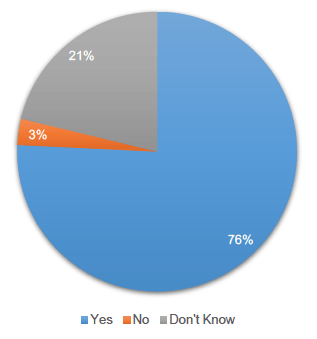
Source: Consultation Hub
For the second part of Question 11, there were 22 valid responses recorded, 26% of all respondents.
Within these responses, 5 free-form responses are included as they covered matters relevant to the question. Three recurring themes were identified in the responses to Question 11. Various responses which did not address a common theme were captured under “Other”. Themes identified:
- Governance
- Stakeholder Engagement
- Ethical Investment
The responses per grouping are profiled in Figure 16, it should be noted that some responses covered more than one theme.
Figure 16: Question 11 Themes
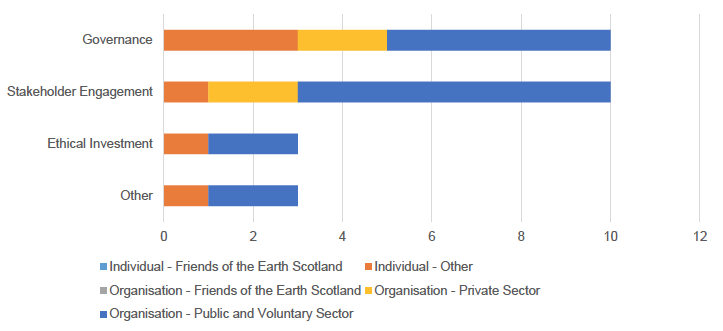
Source: Consultation Hub
Governance
There were differing views as to the recommended size of the Board, with one respondent recommending a limit of 9, and another recommending a maximum of 12, with two thirds of the Board being non-executive directors.
A small number highlighted the importance of stakeholder input, with one respondent focusing on the input from trade union organisations, and another highlighting the importance of geographical coverage when appointing the Board. Additionally, one respondent stressed the need to hire the best talent possible to the Board, to establish credibility for the Bank.
One respondent reiterated the importance of the Bank being publically owned in perpetuity. Finally, one respondent stated the governance should be free of political influence, whilst another questioned how it can be ensured that the Bank is run ethically through the governance framework in place.
Stakeholder Engagement
Respondents were supportive of stakeholder engagement, and aware of the importance of a wide representation within the governance structure. A small number of respondents suggested specific stakeholder involvement, including those with expertise in the environment, social sciences, local government, finance, trade unions; as well as fair representation of women, black and ethnic minorities, and disabled people.
One respondent highlighted the importance of the chosen structure to ensure the Advisory Group engagement is genuine. Finally, one respondent suggested the Advisory Group should have access to both the government and the Bank governors.
Ethical Investment
One respondent advocated that investment should align to the “One Planet Prosperity” principle. One respondent raised concern over the political influence the Scottish Government could have, leading to a push on return of investment rather than staying true to its ethical investment. Finally, one respondent suggested Bank products should align with the agreed Investment and Risk Strategy without further approval from Ministers.
Other
One respondent stressed the importance of Freedom of Information responsibilities being included as Unalterable Articles of the Memorandum of Incorporation.
Another respondent asked that the gender representation objective in the Gender Representation on Public Boards (Scotland) Act 2018 be extended to the Board of the Bank and that representation should reflect principle of diversity found in the proposed ethics statement.
Finally, one respondent wanted to ensure that the accountability of the Board to Ministers should be set out.
Question 12
Respondents were asked to provide comments on “the need for the Bank to have Delegated Powers”. There were 14 valid responses recorded, 17% of all respondents. Within these responses, 2 free-form responses are included as they covered matters relevant to the question. One recurring theme was identified in the responses to Question 12.
- Delegated Powers
The responses per grouping are profiled in Figure 17.
Figure 17: Question 12 Themes

Source: Consultation Hub
Delegated Powers
Several respondents supported the delegation of powers to the Bank, emphasising the need to operate commercially and independently from Government. However, one respondent who supported the delegation of powers warned that governance of the Bank must remain accountable to Ministers and stakeholders.
One respondent opposed the delegation of powers fearing that independence from the Government could lead to investments that undermine the environment and social wellbeing. Finally one respondent suggested accountability mechanisms should include parliamentary scrutiny as well as ministerial oversight.
Question 13
Respondents were asked to provide views on “whether and how an Advisory Group could provide advice to Ministers on the progress being made by the Bank”. There were 29 valid responses recorded, 35% of all respondents. Within these responses, 1 free-form response is included as it covered matters relevant to the question. Three recurring themes were identified in the responses to Question 13. Various responses which did not address a common theme were captured under “Other”. Themes identified:
- Governance
- Stakeholder Engagement
- Openness and Transparency
The responses per grouping are profiled in Figure 18, it should be noted that some responses covered more than one theme.
Figure 18: Question 13 Themes
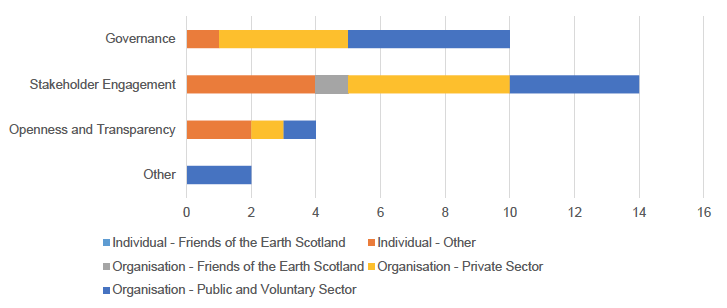
Source: Consultation Hub
Governance
There were differing views towards the establishment of an Advisory Group. A small number of respondents were unsupportive, stating that the Advisory Group was unnecessary and should only be considered if it was deemed appropriate in the future. One respondent raised concern over the possibility of the Advisory Group developing into a shadow board, which could cause issues over governance, while one respondent stated quarterly reporting from the Bank to Ministers should be sufficient.
Conversely, a small number of respondents were supportive of the Advisory Group highlighting its ability to offer long term strategic development advice. One respondent supported the Advisory Group providing advice to both Minister and the Board. Finally, one respondent suggested the Advisory Group would benefit from a dedicated secretariat to operate effectively.
Stakeholder Engagement
All responses supported the need for meaningful stakeholder engagement, however, there were differing opinions regarding representation on the Advisory Group. A small number of respondents suggested prioritising experience within the financial sector, and particularly experience with delivering patient capital. Some respondents emphasised the importance of diversity within the Advisory Group. Within these responses, a small number, including Friends of the Earth Scotland, recommended the Advisory Group focused on representation from trade unions, and marginalised groups within Scotland, and strive for gender diversity, as opposed to prioritising bankers and financial experts.
A small number of responses proposed alternatives to the Advisory Group structure. One respondent suggested the development of a group that engages with the public, and allows democratic decision making. Another respondent suggested industry specific workshops should be run regularly to allow the Bank to understand its customers, and monitor its progress.
Finally, one respondent asked for further clarification as to whether the Advisory Group would have the scope for targeted appointments that reflect key stakeholder groups and sectors, and another respondent reiterated that the Advisory Group should have direct communications with both the Bank and the Ministers.
Openness and Transparency
One respondent suggested details relating to financing of loans and turnover levels of businesses that are receiving support should be provided to Ministers.
One respondent suggested the Advisory Group could produce an independent annual report regarding the Bank’s progress against mission objectives. Another respondent suggested the Advisory Group chair be elected from and by the group, rather than Ministers, to maintain independence. Finally, one respondent stated the importance of the Advisory Group having no political influences.
Other
One respondent emphasised the importance of the Advisory Group members having expertise in the economy and the environment. Another respondent listed the areas where the Advisory Group could specialise in, including financial markets and investments, portfolio management, regulatory compliance, local economies and key growth sectors, and inclusive growth and equality.
5.5. The Bank’s staffing and employment arrangements (Questions 14 to 16)
This section discusses the views and opinions of the respondents in assessing proposed staff and employment arrangements. Respondents were asked to consider three questions:
- Question 14: Do you have views on the initial operating model and costs identified in the Implementation Plan and what are these?
- Question 15: Do you have views on any criteria for the approach to remuneration for senior and specialist roles in the Bank?
- Question 16: Do you have views on areas where the current approach to public sector pay would suit the needs of the Bank, and are there other examples of variations in public pay policy that would be suitable for the Bank and any areas where some changes may be needed?
All three questions were open-ended and allowed respondents to provide comments on the question.
Questions 14 to 16 have been considered collectively in the following section. There was significant overlap in responses to these questions, therefore, it was considered appropriate to analyse the responses collectively.
Questions 14 to 16
Respondents were asked to provide views on the Bank’s staffing and employment arrangements, this included views on the operating model, approach to remuneration for senior roles and how this fits with the Public Sector Pay Policy.
For Question 14 there were 15 valid responses recorded, 18% of all respondents, and for Question 15 there were 28 valid responses recorded, 33% of all respondents. Within these responses, 2 free-form responses are included as they covered matters relevant to the question. For Question 16, there were 13 valid responses recorded, 15% of all respondents.
Three recurring themes were identified in the responses for Questions 14 to 16. Various responses which did not address a common theme were captured under “Other”.
- Staffing Costs
- Operational Costs
- Stakeholder Engagement
The responses per grouping are profiled in Figure 19, it should be noted that some responses covered more than one theme.
Figure 19: Questions 14 to 16 Themes
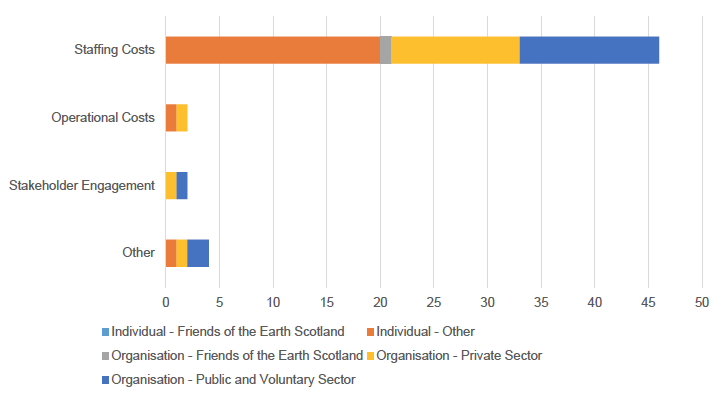
Source: Consultation Hub
Staffing Costs
There were differing responses regarding both the hiring of staff and remuneration policy. Several respondents supported Public Sector Pay Policy, while offering competitive salaries to those individuals whose private sector experience was key to the success of the Bank. These respondents recognised the need to have a competitive salary that attracts individuals with relevant experience and skills and that this will come at a higher cost than is currently offered within the public sector. A small number of respondents commented that any market rate remuneration policy had the potential to become excessive, and could cause the public to lose trust and support in the Bank. Finally, a small number of respondents suggested any market rate salary should be fully justified, with one respondent suggesting this should be approved on a case-by-case basis.
A small number of responses came with caveats; one emphasised that any pay structure should not undermine the integrity of the Public Sector Pay Policy, while another suggested that any bonuses should be tied to the delivery of environmental, sustainability and inclusivity objectives. One respondent stressed the importance of a diverse recruitment policy long term.
A small number of respondents felt it necessary that the Bank adhere completely to the Public Sector Pay Policy, and a pay cap be placed on senior management. Additionally, a small number of respondents specifically advised against the payment of bonuses. One respondent questioned the Bank’s ability to pay staff on non-public sector contracts given that the Bank is expected to be classified as a public sector entity, while another stated the importance of keeping the pay policy consistent within the Bank, and that any market rate pay proposals should be open to public consultation.
There were a small number of respondents who commented on the issues surrounding equality in the Bank if private sector remuneration was offered to those in senior positions. One respondent was worried as to the potential of a toxic culture being created within the Bank. One respondent stated any bonuses should be distributed amongst the entire workforce, while one respondent suggested market rates should be paid to the entire workforce, rather than adhering to the Public Sector Pay Policy.
One respondent felt the budgeted running cost per employee was excessive, and one respondent hoped that the Bank would redeploy existing qualified staff into new roles, before recruiting externally.
Finally, a small number of respondents also expressed support for a fair minimum pay, with one respondent calling for the Bank to become an accredited Scottish Living Wage Employer.
Operational Costs
One respondent agreed that the estimated costs seemed reasonable, stressing the importance of keeping the operating costs as low as possible. Conversely, another respondent thought costs were underestimated.
Stakeholder Engagement
One respondent suggested that the Bank should build on and work with existing institutions such as the British Business Bank, to identify where it can complement existing financing. Another respondent suggested the Bank should utilise external delivery partners, as well as in-house resources, to allow flexibility.
Other
One respondent stressed the importance of ensuring the pay policies and structures do not result in unequal pay, while another respondent suggested the Bank structure should aim to be as flat as possible, in order to share responsibility widely throughout the organisation.
One respondent suggested that incentives should be long-term arrangements that align the interests of the Bank’s management and employees, and Scottish Government.
Contact
Email: Alison.McDonald@gov.scot
There is a problem
Thanks for your feedback